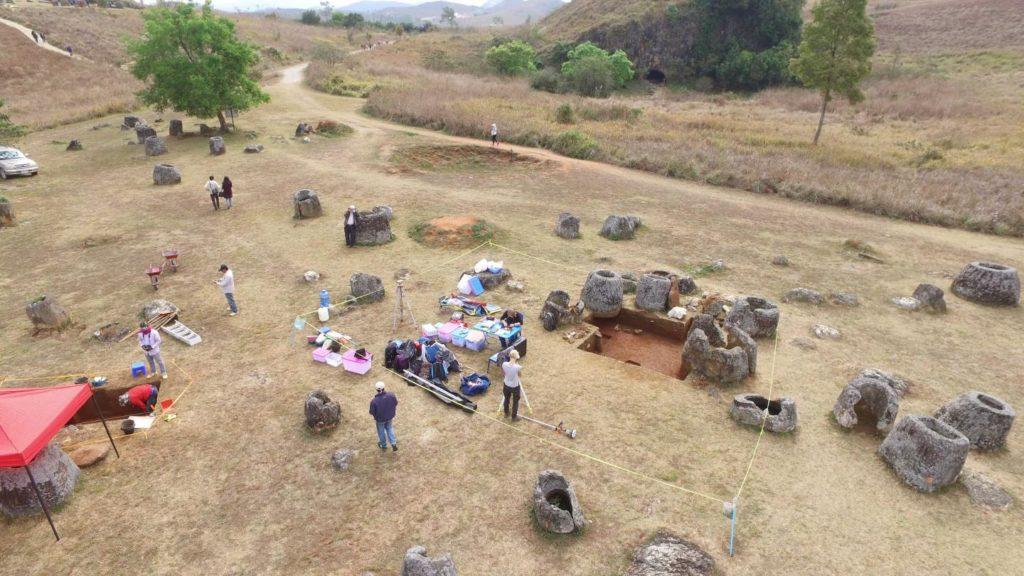Archaeologists Use Drone to Build 3D Virtual Reality Map of Laos’ Plain of Jars
 Just as the emergence of 3D printing technology has been found useful for a number of applications, the rise of drone technology has provided immense benefits to many ventures as well. We’ve covered a wide range of these innovative drone uses, from students helping with marine research to providing first response for medical emergencies, and even for pizza delivery. Now, archaeologists from Australian National University (ANU) and Monash University have utilized drone technology to build a 3D virtual reality map of the Plain of Jars in Laos, one of the most endearing and mysterious sites in all of Asia.
Just as the emergence of 3D printing technology has been found useful for a number of applications, the rise of drone technology has provided immense benefits to many ventures as well. We’ve covered a wide range of these innovative drone uses, from students helping with marine research to providing first response for medical emergencies, and even for pizza delivery. Now, archaeologists from Australian National University (ANU) and Monash University have utilized drone technology to build a 3D virtual reality map of the Plain of Jars in Laos, one of the most endearing and mysterious sites in all of Asia.
The technology used by the archaeology team to create the virtual reality map is called CAVE2, and was developed at Melbourne-based Monash University and uses drone footage to create a virtual map of dig sites. Flying over the Plain of Jars, the drone would capture a set of 3D images every 10 centimeters — this data was then embedded into a digital mold. The researchers can now fully immerse themselves into the virtual reality map of the dig site, allowing them walk around an accurate replica of the famed grounds.
According to Dr. Douglas O’Reilly of the ANU School of Archaeology and Anthropology, the 3D map has provided a number of benefits to the team of archaeologists. Not only are they able revisit a virtual representation of the site, the virtual reality model can even be 3D printed, allowing people to view wondrous relics without damaging the actual artifact. Currently, the archaeologist is using the virtual reality map to observe the positioning of objects that he’s having radio-carbon dated.
“It provides easy access to remote faraway places. Theoretically you could use the headset with your phone to visit a 3D map of any location,” said O’Reilly. “You could print a life-sized version of any CAVE2 model. You could use them in museums rather than disrupting the archeologically record by moving artifacts.”
The Plain of Jars project is the first major archaeological dig in central Laos since the 1930s, and is currently listed as a UNESCO World Heritage site. The landscape is full of mystery, including ancient carved stone jars that measure up to three meters tall, as well as a big sandstone disk and large quartz stones.
Dr. O’Reilly headed the project in tandem with Monash University’s Dr. Louise Shewan, who has said that the CAVE2 technology will also become useful for investigating sites that are not accessible by traditional archaeological methods. For instance, the Plain of Jars site has a number of unexploded land mines, and just 7 of the 80 known jar sites in the area have been cleared of these explosives. All in all, this archaeology project is yet another example of how drone technology is being used to help preserve the earth and keep people safe, while the virtual reality map places us in the midst of hard to reach or dangerous places. Discuss in the Monash University forum at 3DPB.com.
[Source: EurekAlert via Douglas O’Reilly / Images: ANU]Subscribe to Our Email Newsletter
Stay up-to-date on all the latest news from the 3D printing industry and receive information and offers from third party vendors.
Print Services
You May Also Like
New Business: Temporary, Migratory, & Modular 3D Printed Architecture
If we look at potentially emerging 3D printing businesses, then architecture has not been fully explored. Yes, there is a lot of house 3D printing going on worldwide. From deployable...
3D Printing News Briefs, April 19, 2025: Material Extrusion Standard, Metal Powder, & More
In today’s 3D Printing News Briefs, we’re covering a proposed standard for material extrusion, before moving on to business and metal powder. We’ll end with a commercial store’s robotic 3D...
Japan Unveils World’s First 3D Printed Train Station
Japan is now home to what we believe is the world’s first train station built with 3D printing technology. Located in Arida City, just south of Osaka, the new Hatsushima...
restor3d Raises $38M to Expand 3D Printed Orthopedic Implants
Backed by $38 million in new funding, restor3d is pushing ahead with the launch of four personalized implant lines, set to roll out in 2025 and 2026. This latest venture...



























